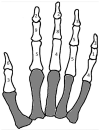Reoperation After Operative Treatment of Open Finger Fractures
- PMID: 35392688
- PMCID: PMC10798210
- DOI: 10.1177/15589447211043191
Reoperation After Operative Treatment of Open Finger Fractures
Abstract
Background: Our primary aim was to develop a prediction model for return to the operating room (OR) after open finger fractures by studying the reoperation rate of open finger fractures based on patient demographics, injury mechanism, injury severity, and type of initial surgical fixation. The secondary aim was to study the predictors for secondary surgery due to nonunion, postoperative infection, and secondary amputation.
Methods: In the retrospective chart review, 1321 open finger fractures of 907 patients were included. Demographic-, injury-, and treatment-related factors were gathered from medical records.
Results: We found that open fractures involving the thumb had lower odds of undergoing secondary surgery. Crush injury, proximal phalangeal fracture, arterial injury, other injured fingers, and other injuries to the ipsilateral hand were associated with higher odds of undergoing secondary surgery. However, the associated factors we identified were not powerful enough to create a predictive model. Other injury to the ipsilateral hand, vein repair, and external fixator as initial treatment were associated with postoperative nonunion. Crush injury and proximal phalangeal fracture were associated with postoperative infection. No factors were associated with secondary amputation.
Conclusions: A quarter of open finger fractures will likely need more than one surgical procedure, especially in more severely injured fingers, due to crush or with vascular impairment. Furthermore, fractures involving the thumb have less reoperation, while fractures involving the proximal phalanx have poorest outcomes.
Keywords: amputation; finger; infection; nonunion; open fracture; reoperation.
Conflict of interest statement
Declaration of Conflicting InterestsThe author(s) declared no potential conflicts of interest with respect to the research, authorship, and/or publication of this article.
Figures
Similar articles
-
Phalangeal Fractures Requiring Vascular Reconstruction: Epidemiology and Factors Predictive of Reoperation.Hand (N Y). 2024 Mar;19(2):247-255. doi: 10.1177/15589447221109635. Epub 2022 Jul 19. Hand (N Y). 2024. PMID: 35852405 Free PMC article.
-
Delays to Surgery and Coronal Malalignment Are Associated with Reoperation after Open Tibia Fractures in Tanzania.Clin Orthop Relat Res. 2020 Aug;478(8):1825-1835. doi: 10.1097/CORR.0000000000001279. Clin Orthop Relat Res. 2020. PMID: 32732563 Free PMC article.
-
Risk Factors for Nonunion After Distal Phalangeal Fractures of the Hand.J Hand Surg Am. 2025 Apr;50(4):501.e1-501.e6. doi: 10.1016/j.jhsa.2023.10.003. Epub 2023 Nov 11. J Hand Surg Am. 2025. PMID: 37952146
-
Methods and pitfalls in treatment of fractures in the digits.Clin Plast Surg. 2014 Jul;41(3):429-50. doi: 10.1016/j.cps.2014.03.003. Clin Plast Surg. 2014. PMID: 24996463 Review.
-
Static fixation of finger fractures.Hand Clin. 1993 Nov;9(4):639-50. Hand Clin. 1993. PMID: 8300733 Review.
Cited by
-
Phalangeal fractures: A retrospective comparison of open reduction and internal fixation vs. closed reduction and percutaneous pinning.J Hand Microsurg. 2024 Jul 2;16(4):100124. doi: 10.1016/j.jham.2024.100124. eCollection 2024 Oct. J Hand Microsurg. 2024. PMID: 39234367 Free PMC article.
-
Phalangeal Fractures Requiring Vascular Reconstruction: Epidemiology and Factors Predictive of Reoperation.Hand (N Y). 2024 Mar;19(2):247-255. doi: 10.1177/15589447221109635. Epub 2022 Jul 19. Hand (N Y). 2024. PMID: 35852405 Free PMC article.
References
-
- Feehan LM, Sheps SB. Incidence and demographics of hand fractures in British Columbia, Canada: a population-based study. J Hand Surg Am. 2006;31(7):1068-1074. - PubMed
-
- Ng T, Unadkat J, Bilonick RA, et al.. The importance of early operative treatment in open fractures of the fingers. Ann Plast Surg. 2014;72(4):408-410. - PubMed
-
- Swanson TV, Szabo RM, Anderson DD. Open hand fractures: prognosis and classification. J Hand Surg Am. 1991;16(1):101-107. - PubMed
-
- Bannasch H, Heermann AK, Iblher N, et al.. Ten years stable internal fixation of metacarpal and phalangeal hand fractures-risk factor and outcome analysis show no increase of complications in the treatment of open compared with closed fractures. J Trauma. 2010;68(3):624-628. - PubMed
-
- McLain RF, Steyers C, Stoddard M. Infections in open fractures of the hand. J Hand Surg Am. 1991;16(1):108-112. - PubMed
MeSH terms
LinkOut - more resources
Full Text Sources
Medical


